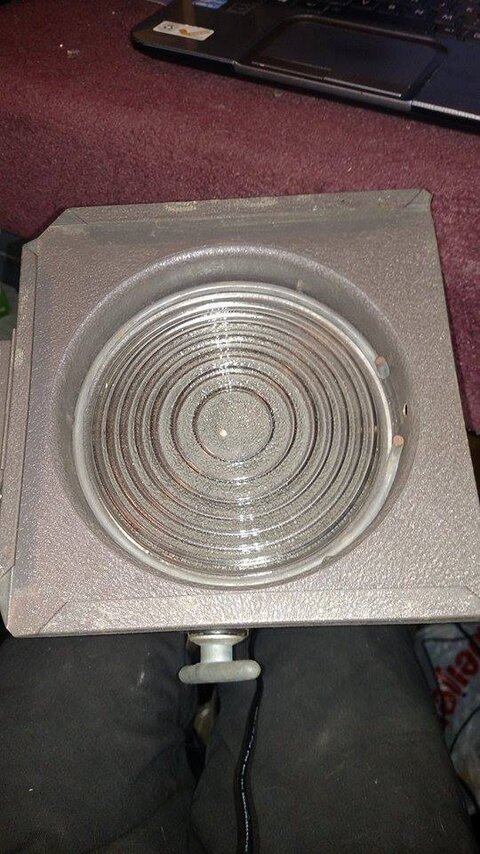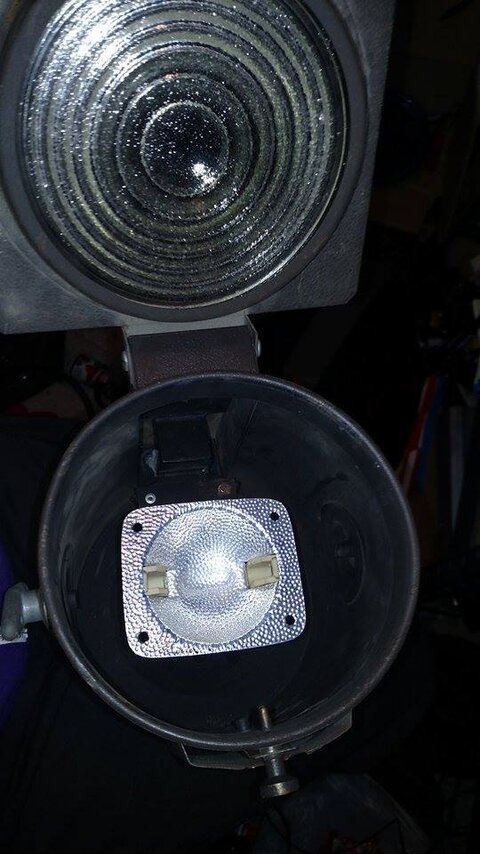That's not good, but hardly fatal and probably to be expected if plain old extension
cord was used in the last rewire. As you have probably noticed, these things run hot. Replace with high temperature
fixture wire (150 degree C min. 200 degree C rated is better if you can get it. Teflon
insulation is good, but I like to back that up with silicon coated glass sleeving where it passes through the
fixture [Teflon can cold flow and will do so quicker at higher temperatures]). The sleeving also adds some abrasion resistance. If
crimping and splicing inside the
fixture use high temp non-insulated crimps. These are actually sold in many hardware stores for redoing connections in ovens (If the hardware store sells
electric burner elements for stoves and ovens, there is a good chance they will carry high temp lugs, splices, fastons,
etc.
I second the fiberglass coated advantages. Often I will use 200c
wire for the conductors and 150c Teflon non-coated for the
ground. This way when servicing the
fixture if I see the
insulation over the
ground is deteriorating I know it's been overheating. (In addition to the step of looking at the contacts of the bad lamp as it's replaced to get an indication of if the lamp has charring to it's
base, the
socket will also so it should not be re-lamped but instead pulled from service to service.) This
ground wire insulation damage possibly from a bad
socket or connection. Any theatrical supplier will
stock SF-2 the 200c sleeving in black and white, the black #0 size fiberglass over sleeving, and many will also
stock the Type K or FEP 150c heat
wire. Might also
stock the high temperature terminals. The
Altman assembly check with your theatrical supplier but I believe comes with the wiring already installed. Given your fixtures are
RSC/R-7s dual ended, you do not need to buy one each black and white unless doing Europe on tour. Can both be either black or more properly white.
On the
crimp barrel of the high temp.
ring terminal install three wraps of 3M Scotch #27 or 69 high temperature fiberglass electrical tape. I normally use 1/2" wide but 3/4" will also work. (McMaster Carr or Grainger for terminals and tape amongst other sources) This will help protect aganst the
barrel of the
ring terminal shorting to anything and prevent the fiberglass
insulation from un-braiding at the
terminal. If the
fixture has a two screw clamp style
cord grip instead of a plastic
heyco style
cord grip, a few layers of fiberglass electrical tape 1" - 1.1/2" wide here is also really useful in preventing the
fixture cord from wearing out.
(By the way if
Heyco style
cord grip in use, thought everyone knew, but there is a installation/removal tool for such
cord grips. The old one is normally shot but replacements are cheap. Having the tool is much simpler in somewhat easy to deal with for properly installing such a
cord grip.)
At the
cord grip, I normally wrap the three conductors with the heat tape to band them together and without cutting it slide the fiberglass over sleeving over this wrap of tape. I now wrap the fiberglass sleeving a few layers thick down about an inch and a half or so and cut the tape always at the top so it's end winds up under the clamp. The tighter weave on the tape and added
thickness prevents bending the
cord too close at the
strain relief and from the
cord grip cutting into it. It also prevents the fiberglass oversleeving from pulling out of the
cord grip.
Figure out what size screw is in use at the termination to contact - normally a #6 in general, but on this dual ended
socket could be a #4 if not crimped termination not removable. (Details if that's the case.) The screw should at least be able to come out as opposed to many P-28s lamp sockets that won't allow the screw to come out. If you need to use liquid wrench but be sure to clean away with soap or degreaser any oil used to get the screw out. You need to know what size stud or screw is in use before buying your
ring terminal. A #6 will work if you can't get a #4 for high temperature, but isn't optimum.
Do a brass
wire weel on a Dremmel tool to the contact area, you can also re-surface the ball of the lamp
terminal with this
wire wheel. You need to remove any corrosion and get back to fresh bright contacts. A silicone abrasive polishing wheel for the Dremmel will work better for this bright work purpose but it's a McMaster Carr order part not otherwise in stores. Can furnish part numbers on request. Brass
wire wheels will otherwise for the most part work fine and are available from anyone that sells Dremel tools. Once you have fresh bright work you need to treat it or it will begin to oxidize again. Many recommend Craig's De-Oxite, especially the copper infused version (available on
line) I have never tried it. I use Electrical Contact Cleaner w. Lubericant 16oz. Spray McMaster #7437k15 on up to 5Kw Fresnels.
If the
fixture isn't grounded, a good time to do it and easy enough but another discussion.
Once the brightwork is done, re-tap the threaded connection holes dry - do not use cutting oil and either also re-tap the screws or it's normally better to just replace the screws with new brass ones. Add a silicone coated bronze internal tooth lock washer between the screw and the
ring terminal. (Same sources on screws and lock washers.) This will help prevent the
ring terminal from loosening as the
wire moves during focus. If the contact area under the
ring terminal is pitted or isn't coming bright after cleaning, add another lock washer under the
ring terminal and it should help with contact.
High temperature ring terminals are made of harder metal than standard
crimp terminals, I have even broken
crimp tools with them. You are best going to an electrical supply store and getting what's industry called a "Stakon tool" It is a
crimp tool designed for
crimping terminals - not some "multi tool" that has weak mechanical advantage in
crimping pressure and normally just crushes over a small surface area. Goal is to displace material not to smash and let the
wire settle with expansion and contraction into a loose
crimp contact. I buy the Klien #1005 and #1006 and recommend them. 1005 for 14-16ga
wire, 1006 for the others. Ideal #30-425 while it works really well on insulated terminals, doesn't as well for these smaller gauges non-insulated. I often prefer this tool for 12ga
thru 6ga crimps insulated or not. Remember to put the saddle in the seam. In other words it would be a bad
crimp if the seam of the
crimp had the jaw (tooth) of the
crimp tool go into the seam of the
crimp terminal. Always leave your
crimp tool on the
terminal after
crimping and tug hard on the
wire with it after
crimping for the initial crimps. Frequently on a
crimp terminal it is thought tight enough but not in causing problems down the
road or wrong place crimped on an insulated
terminal, or perhaps the
wire pulled free while crimping- I even do this after 20 years+. if the experienced people do and teach, others will follow in getting proper crimps as a constant failure problem in addition to the wrong
crimp tool used.
On the
wire and
crimp terminals (finally), 18ga heat
wire will work but a good standard to use is 16ga
wire for anything under 1Kw. It will work better in the
strain relief, less chance of breaking from wear, and deal with
current issues from heat resistance later better. That said for the ring terminals, you will find that a 18-22ga
ring terminal will normally fit better on a 16ga
wire than a 14-16ga
wire terminal. Use them unless your heat
wire is 56
strand. Normal SF-2
wire has 19 strands of
wire to the
conductor, the more flexible 56
strand wire will be larger and need the larger
ring terminal. Heat
wire at 150c or 200c are different than normal
jumper 90c or 105c cable in that at higher temperatures it can be a little less in actual size. 2,000w Fresnels wired with 14ga
wire for instance don't seem correct but is. General rule is when buying
wire know also the stranding of it. No problem either way but different terminals to be used.
Send more phototos and how you are doing type stuff in us all living vicariously
thru your project. Wish I could give more classes and train more in detail.





